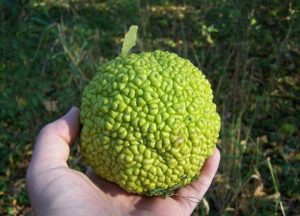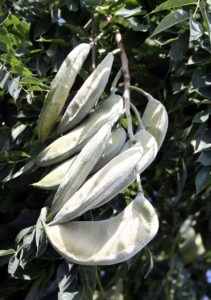I was trimming low branches under my Norway spruce a few days ago, making room for some leftover stones from my driveway wall re-construction, when I found a white oak seedling growing along with some struggling Virginia creeper and poison ivy. The seedling looked quite healthy in the cool, moist, but almost sunless space under the spruce, and since, at least until very recently, there have been no white oaks growing on my property, I assumed that this seedling’s acorn was flown in a few years ago and accidentally dropped by a blue jay or crow.
Reproducing oak trees invest a substantial amount of their metabolic energy into their acorns. They make their acorn “packages” as appealing as possible to a wide range of birds and mammals and count on some acorn consumers being clumsy with these nutritious morsels. A few of the acorns will, hopefully, be dropped in places where germination is possible and where seedling browsers aren’t abundant. I was looking at the winner of an intense reproduction gauntlet: an oak seedling growing far from the parental tree.
In a nutshell (sorry, very bad pun!) that’s why plants have evolved fruit and nuts! Inside these tempting pieces of food are the embryos of the plants’ next generation, and those plants that can use animals to fly or walk at least some of these embryos to more distant habitats will disperse, thrive and then go on to produce more and then even more individuals. They will be more likely to “win” the great biological contest of survival and replication!
There are examples of this process all over my yard and field: there are chestnut seedlings growing in several corners of my two acres where squirrels, carrying the nuts dropped them (or buried them) and then went off to do something else. I have watched gray squirrels carrying chestnuts that are still encased in their spiky burrs suddenly stop, shake their heads and fling the nut away. My sense is that one of the burr spikes jabbed itself into the flesh of the squirrel and triggered the reflexive shudder and toss! Could the sharp spikes of these burrs be more than just protective barriers against non-dexterous nut predators? Maybe they are dispersal triggers, too? The latter might even be more important in an evolutionary scheme!
Fruit is designed to attract consumers at just the right time so that the mature plant seeds can go for a ride often inside of the fruit consumer’s intestines. The seeds then leave the consumer along with a dollop of fertilizer (feces has many uses!), and, if all of the environmental variables line up, the seeds germinate, grow, survive and then also reproduce. I look around my yard and see raspberry thickets, mulberry trees, grape vines, cherry seedlings, and poison ivy growing in perfusion all thanks to the bird dispersal of each species edible and enticing fruit!
So, fruits are made to be eaten (seed and all) and the payoff for the plant, as I have said before, is the sudden acquisition of wings and legs!
There are a few apparent glitches in this scheme, though. There are quite a few plants (especially some trees) that have fruits that either can’t be eaten or seeds within their fruit that would, quite literally choke a horse. A seed that can’t be swallowed will be very hard to disperse! The plant’s investment into that fruit and seed, then, does not result in the big dispersal payoff (it more closely resembles the investments that I have in my retirement portfolio!).
Dan Janzen (University of Pennsylvania) is a renowned tropical ecologist (and the author of the 1983 book Costa Rica Natural History which I have enjoyed and relied on as an authoritative reference for the past thirty years). Many years ago Janzen noticed that a middle canopy tree of the rain forest of Costa Rica called the “pink shower tree” (or Cassia grandis) had long, woody seed pods that were not eaten by any of the native animals of Costa Rica. These seed pods, though, were avidly consumed by cattle and horses (both of which were alien exotic species in these ecosystems!). He eventually described about forty other tree species of these forests that produced fruits that were not eaten by any of the native animals! Unconsumed fruit meant non-dispersed seeds! The evolutionary “fruit and seed dispersal contract” was not being honored in today’s ecosystems!
Janzen in collaboration with Paul Martin of the University of Arizona developed the idea of “ecological anachronisms.” The Costa Rican trees must have developed their fruits in co-evolutionary relationships with large animals that had since gone extinct! These trees without their giant ground sloths or massive, elephant-like gomphotheres now were investing their precious metabolic energy into a seed disposal system that no longer existed! They had become “ecological anachronisms.”
A tree that grows closer to home that also reflects a hidden evolutionary history is the Osage orange (Maclura pomifera). The fruit of the Osage orange is a large, seed-filled, softball sized sphere that contains a white, sticky fluid. No animal eats these fruit and, not surprisingly, the Osage orange has a very restricted natural range (in east-central Texas,
southeastern Oklahoma, and northwestern Arkansas) even though it is very well adapted to grow throughout the continental United States and southern Canada (it has been planted, often as a living fence, in 39 of the lower 48 states!). This natural range restriction is undoubtedly due to the absence of natural seed disperses (probably mammoths or giant ground sloths, two species that went extinct in the later Pleistocene when, coincidentally or not, humans first came to the North American continent).
There are many other temperate and tropical trees that have fruit and seeds that are anachronistic: the large seed pods of the Kentucky coffee bean tree and the honey locust (two trees that my students and I have planted in conjunction with the Pennsylvania “Tree Vitalize” program) are not eaten by native animals (and both tree species have very constricted natural ranges in spite of their robust ability to grow under a wide variety of conditions (as demonstrated by their survival along the streets of New Kensington and many other towns in Western Pennsylvania!)). Avocados, as Lee Drake pointed out last March in Albuquerque, look like giant ground sloth or mastodon food to me! So do papayas, pawpaws, persimmons, and even wild squash! Big fruit and seeds require big mouths and big intestines to be ecologically and evolutionarily functional!
There are many features of our trees and forests that reflect other ecological anachronisms and relationships with departed species. Whit Brounaugh wrote a wonderful article entitled “The Trees That Miss the Mammoths” in the Winter 2010 issue of American Forests, and George Monbiot wrote “Thinking Like an Elephant” in the June 2015 issue of BBC Wildlife. Growth patterns of trees, the strength of their trunks and branches, the patterns and sizes of their protective thorns, etc. all suggest a long, adaptive evolutionary interaction between the trees and large browsers and seed dispersers that no longer exist.
Many of our trees have been sculpted by evolutionary and ecological ghosts, and the momentum of these evolutionary changes has continued even long after these “prime movers” were gone!








Very educational! Examples of contemporary adaptive coevolution are well known, but I don’t recall being introduced before to this concept of ecological anachronisms.
Thank you.